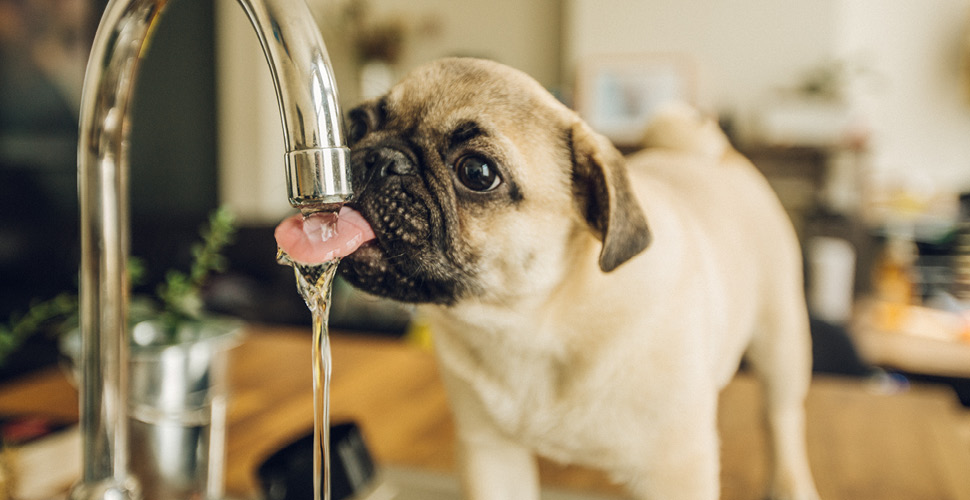Summer may be winding down but those temperatures are staying steady. We’re finally in the dog days of summer with its blazing sun and long, languid days. The radiant summer days can be challenging for our four-legged companions. Let’s delve into the importance of pet hydration and learn how we can ensure their well-being during these heated months.
Spotting the Signs of Dehydration
Water plays a pivotal role in our pets’ health, aiding digestion, circulation, and waste elimination. However, during the hotter months, pets are more susceptible to dehydration, a silent but severe threat. Recognizing the early signs is crucial for their well-being.
How do you discern a thirsty pet from a dehydrated one?
Gum Check: Gently press on your pet’s gums. Normally, when you press on the gums, they turn white but should return to a pink color quickly once you remove your finger. If the pink color is slow to return, this could be a sign of dehydration.
Tacky Gums: Another gum-related test is to feel the moistness of the gums. A dehydrated pet will often have sticky or tacky feeling gums due to the lack of moisture.
Concentrated Urine: If your pet’s urine is darker than usual, it might indicate dehydration. A properly hydrated pet usually has light yellow urine. Dark yellow or amber urine suggests that the body is conserving fluids.
Reduced Skin Elasticity: Gently pinch and pull up the skin at the back of your pet’s neck or between the shoulder blades. In a hydrated animal, the skin should spring back quickly into place. If the skin returns slowly or remains elevated, it’s a sign of reduced elasticity which can indicate dehydration.
Nose and Eyes: A dry nose, while not a definitive sign of dehydration, can sometimes be an associated symptom. Additionally, if your pet’s eyes appear sunken or dry, it could be another indication.
Loss of Appetite: Pets may lose interest in food when they’re dehydrated. While loss of appetite can be a symptom of many issues, combined with other signs, it can indicate dehydration.
Increased Heart Rate: Dehydration can lead to an increased heart rate in pets. If you notice your pet’s heartbeat is faster than usual, combined with other symptoms, you might be dealing with a dehydrated animal.
Reduced Activity or Lethargy: Dehydrated pets might be less active, seem tired, or lethargic. They may not have the energy or interest in their usual activities.
Delayed Capillary Refill Time: Press on your pet’s gums until they turn white and then release. Count how long it takes for the color to return. If it takes longer than 1-2 seconds, it might indicate dehydration.
Increased Thirst: A paradoxical symptom, but sometimes pets that are becoming dehydrated will drink more in an attempt to rectify the balance. If you notice your pet is drinking more than usual, keep a close eye on them.
Creative Hydration Solutions
With pets, especially cats, getting them to drink water can sometimes be a challenge. Here are some innovative tactics:
- Frozen Delights: Ice cubes or frozen treats can be both hydrating and entertaining.
Wet Food: Incorporate more wet food into their diet. It’s an easy way to sneak in extra moisture. - Fountains Over Bowls: The allure of moving water can be enticing for many pets, encouraging more frequent sips.
- Broth Boost: Occasionally, adding a splash of pet-friendly broth to their water can make it more appealing.
The Role of Pet Care Professionals
Pet care professionals, whether they’re veterinarians, groomers, or boarders, play a pivotal role in championing hydration.
- Education: Regularly update pet owners on the importance of hydration, especially during hot months.
- Routine Checks: During appointments, a quick hydration check can be performed, ensuring that pets are in optimal condition.
- Special Services: Consider offering hydration-focused services, such as specialized baths or water-based therapies.
- Hydration Stations: For boarders or daycare centers, ensure that fresh water is always available. Incorporate hydration breaks during playtime. This is easy to accomplish with Kinn Kleanbowl. With our Nourish-Pet Refills you can easily swap out dirty bowls for a fresh bowl each day. Say goodbye to washing dishes with Kinn Kleanbowl.
Incorporating Hydration into Daily Routines
Much like we prioritize sunscreen during summer or umbrellas during the rainy season, hydration for our pets must become a daily ritual.
- Timed Bowls: Set a timer to remind you to refill or replace your Nourish-Pet Refill and refresh your pet’s water.
- Location, Location: Place multiple water sources around your home. Ensure there’s always one in the shade if they’re outdoors.
- On-the-Go Hydration: When heading out, carry a portable water dish. Kinn Kleanbowl also offers easy hydration on-the-go thanks to the recyclable or compostable Nourish-Pet Refills. Make water breaks a fun part of your journey.
- Monitor Intake: Keep an eye on how much they’re drinking. Over time, you’ll recognize their patterns and quickly spot any deviations.
As temperatures soar and we find solace in pools, air conditioning, and icy treats, let’s remember our loyal companions. Their hydration is paramount for a fun-filled, healthy summer. So, as we embrace the warmth, let’s also embrace the responsibility, ensuring our pets are hydrated, happy, and ready to enjoy every sun-kissed moment with us.
At Kinn Inc., our commitment goes beyond products. We cherish the bond between pets and their parents, and through insights and care, we strengthen this bond each day. Stay connected for more pet-centered wisdom. For now, grab that bowl, fill it up, and toast to a hydrated summer ahead!


